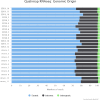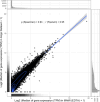Isolating high-quality RNA for RNA-Seq from 10-year-old blood samples
- PMID: 39730418
- PMCID: PMC11681174
- DOI: 10.1038/s41598-024-80287-4
Isolating high-quality RNA for RNA-Seq from 10-year-old blood samples
Abstract
There is much interest in analysing RNA, particularly with RNA Sequencing, across both research and diagnostic domains. However, its inherent instability renders it susceptible to degradation. Given the imperative for RNA integrity in such applications, proper storage and biobanking of blood samples and successful subsequent RNA isolation is essential to guarantee optimal integrity for downstream analyses. Especially for larger collections, it would be particularly beneficial if these methods would additionally offer affordability, minimal blood volume requirements and also long-term storage. In this study, RNA of high quality, suitable for transcriptomics, has been successfully isolated from 400 µL of EDTA and citrated whole blood samples in Boom's lysis buffer stored at -85 °C for 10 years. Isolation was carried out using a modified Zymo Research Quick-RNA kit protocol. This isolation method showed significant improvement in RNA integrity when compared to RNA extracted using the original Boom method. RNA Sequencing provided high-quality data comparable to that of other studies using recently frozen blood in RNA stabilisation tubes. Additionally, sequencing data from blood collected in citrate and EDTA anticoagulants also showed excellent correlation.
Keywords: Biobanking; Long-term storage; Multi-omics; RNA isolation; RNA-Seq; Transcriptomics.
© 2024. The Author(s).
Conflict of interest statement
Declarations. Competing interests: The authors declare no competing interests.
Figures





Similar articles
-
Recovery of microarray-quality RNA from frozen EDTA blood samples.J Pharmacol Toxicol Methods. 2009 Jan-Feb;59(1):44-9. doi: 10.1016/j.vascn.2008.10.003. Epub 2008 Nov 5. J Pharmacol Toxicol Methods. 2009. PMID: 19028589
-
Preservation of milk in liquid nitrogen during sample collection does not affect the RNA quality for RNA-seq analysis.BMC Genomics. 2025 May 24;26(1):525. doi: 10.1186/s12864-025-11707-6. BMC Genomics. 2025. PMID: 40413378 Free PMC article.
-
Optimized protocol for the extraction of RNA and DNA from frozen whole blood sample stored in a single EDTA tube.Sci Rep. 2021 Aug 23;11(1):17075. doi: 10.1038/s41598-021-96567-2. Sci Rep. 2021. PMID: 34426633 Free PMC article.
-
Best practices on the differential expression analysis of multi-species RNA-seq.Genome Biol. 2021 Apr 29;22(1):121. doi: 10.1186/s13059-021-02337-8. Genome Biol. 2021. PMID: 33926528 Free PMC article. Review.
-
Processing and Analysis of RNA-seq Data from Public Resources.Methods Mol Biol. 2021;2243:81-94. doi: 10.1007/978-1-0716-1103-6_4. Methods Mol Biol. 2021. PMID: 33606253 Review.
References
-
- Cooper, G. M. Protein synthesis, processing, and regulation. The Cell: A Molecular Approach. 2nd edition (2000).
-
- Houseley, J. & Tollervey, D. The many pathways of RNA degradation. Cell136, 763–776 (2009). - PubMed
-
- Chheda, U. et al. Factors affecting Stability of RNA – temperature, length, concentration, pH, and buffering species. J. Pharm. Sci.113, 377–385 (2024). - PubMed
MeSH terms
Substances
Grants and funding
LinkOut - more resources
Full Text Sources

